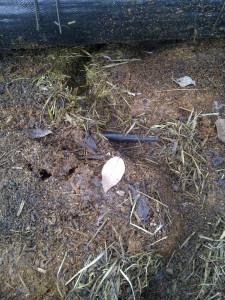Mulches
Mulches are used in the blueberry fields of the UBC Farm to aid in the suppression of weeds, to maintain the soil moisture, and to moderate the soil temperature of the microclimate at the farm (Gliessman, 2007). Allen Straw (2009) states that frequent applications of mulch in thin layers is recommended for fields where rodents such as voles are present. Traps and other controls should be used to prevent the population of the rodents from increasing (Straw, 2009). The three types of mulches that are currently used by the UBC farm are sawdust, control soil, and yard trimmings.
Sawdust

Using sawdust as a mulch for blueberry fields is recommended due to its ability to prevent the heating of the plant roots, to increase water holding capacity of the soil, and to suppress weeds (DeFrancesco & Murray, 2011). Sawdust is also beneficial for the growth of the blueberry roots, the drainage in the soil, and the soil tilth (DeFrancesco & Murray, 2011). The decomposition of the sawdust decreases the pH of the soil which is an advantage to the blueberry fields since the blueberries grow best in soils with a pH between 4.2 and 5.0 (Rakow, 2010; Hall, Aalders & Townsend, 1963).
However, using sawdust mulches has its disadvantages such as the uptake of nitrogen during the decomposition of the sawdust (Rakow, 2010; Straw, 2009). This will prevent the blueberries from taking up the optimal amount of nutrients they could have had from the soil. More nitrogen needs to be applied to the blueberry fields using compost and other organic methods (Straw, 2009). The compaction and decomposition of the sawdust occurs over one growing season so the sawdust mulches must be renewed prior to each season (Rakow, 2010).
YTC (Yard Trimmings Compost)
The benefits of using yard trimmings, such as shredded leaves, includes the addition of humus, nitrogen, and other nutrients (Rakow, 2010). However, in order to use the leaves effectively, they must be shredded into fine pieces (Rakow, 2010). Otherwise, the leaves would form a layer that prevents the input and output of oxygen and water (Rakow, 2010). Yard trimmings also maintain soil moisture, suppress weeds, modify soil temperatures, and lower the risk of soil erosion (Korb, 2008). Grass clippings included in yard trimmings do not require nutrient applications such as fertilizers (Korb, 2008). Korb (2008) states that the pieces of grass used as a mulch do not need a lot of management which means that labour requirements are low. Using yard trimmings as a mulch is also beneficial because they are considered as organic fertilizers and they recycle yard and garden waste that otherwise would have ended up in the garbage (Korb, 2008).
Photo retrieved from http://fresh-basil.com/2011/05/20/mulching-with-leaf-litter/
Black Plastic – Weed Barrier
The main advantages of using black plastic as a weed barrier is that the plastic suppresses weeds, promotes earlier harvest, and increases the soil’s water holding capacity similar to the sawdust mulch (Rakow, 2010; Sanders, 2001). Black plastic had previously been discovered to lower the risk of diseases for two years when they have been covering the soil for several weeks before the blueberries were planted (DeFrancesco & Murray, 2011). Another advantage to using black plastic is that the plastic moderates the soil temperature by keeping the soils warm during cold seasons (Agriculture and Agri-Food Canada, 2007). A disadvantage to using the black plastic is that though the plastic holds water in, it also keeps water out (Rakow, 2010). Therefore, the soil will not have access to fresh water which may become a problem.
References
Agriculture and Agri-Food Canada. (2007). Plastic mulches for commercial vegetable production. Retrieved from http://www4.agr.gc.ca/AAFC-AAC/display-afficher.do?id=1190147996765&lang=eng
DeFrancesco, J., & Murray, K. (2011). Pest management strategic plan for blueberries in Oregon and Washington. Retrieved from http://www.ipmcenters.org/pmsp/pdf/ORWABlueberry.pdf
Gliessman, S. R. (2007). Agroecology: The ecology of sustainable food systems (2nd ed.). Boca Raton, FL: CRC Press. pp. 68
Hall, I.V., Aalders, L.E., & Townsend, L.R. (1963). The effects of soil pH on the mineral composition and growth of the lowbush blueberry. Retrieved from http://pubs.aic.ca/doi/pdf/10.4141/cjps64-084
Korb, G. (2008). Managing leaves and yard trimmings. Retrieved from http://clean-water.uwex.edu/pubs/pdf/managlt.pdf
Rakow, D.A. (2010). Cornell gardening resources: Mulches for landscaping. Retrieved from http://www.gardening.cornell.edu/factsheets/mulch/mulchland.html#top
Sanders, D. (2001). Using plastic mulches and drip irrigation for vegetable production. Retrieved from http://www.ces.ncsu.edu/depts/hort/hil/hil-33.html
Straw, A. (2009). Specialty crop profile: Blueberries. Retrieved from http://pubs.ext.vt.edu/438/438-103/438-103.html
